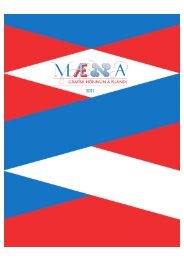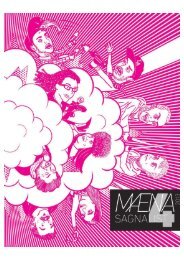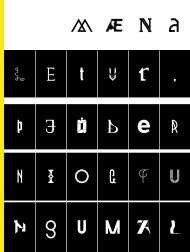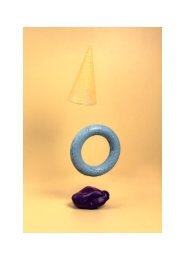You also want an ePaper? Increase the reach of your titles
YUMPU automatically turns print PDFs into web optimized ePapers that Google loves.
90.<br />
My brother Ryan and I are identical twins.<br />
We’ve always been close and discuss almost<br />
everything together.<br />
We also both tend to pay keen attention to our own visual perception,<br />
and in college began discussing observations about our eyes. For<br />
example, even though from the far left of one’s vision to the far right,<br />
the scene you see seems continuous and unblocked, in fact an image<br />
of your own nose blocks both the right and the left sides of your field<br />
of view. By closing each eye in alternation this visible portion of your<br />
nose becomes even more evident, looming large in the periphery.<br />
Small observations like these caught our attention and animated<br />
our discussions.<br />
Simultaneously, another series of investigations being explored<br />
through sculpture led us towards a highly specific, almost scientific,<br />
understanding of the physics of light. This series of sculptures grew<br />
out of a fascination with center-point oriented systems. Because<br />
center-points are so abundant around us and seem important we<br />
wanted to lay artistic claim to them. One sculpture was built out of<br />
wooden matchsticks. Its form emerged spontaneously by packing<br />
many thousand matchsticks next to each other and gluing them<br />
together. Because the match head is wider than the wooden stick,<br />
the group formed into a dome shape. Interestingly this form held the<br />
matchsticks in such a manner that each individual stick was aimed<br />
like an arrow directly towards a floating focus point at the center of<br />
the dome. Through building this form, through becoming extremely<br />
familiar with the spatial formation of matchsticks all aimed towards<br />
one focus point, we began thinking of other entities in nature that<br />
shared this shape. For example, the gravitational pull for an entire<br />
planet can be pictured as pulling everything towards the core. But<br />
even more so, the matchsticks’ formation matched the formation of<br />
light rays as they burst away from their source, in a spherical splay.<br />
Furthermore, when looking into the world, our eye samples an<br />
inverted spherical splay of light rays, too.<br />
To acknowledge this idea that our eyes forever see the world as a<br />
spherical splay of light rays we assembled a sculpture out of corrugated<br />
cardboard. It curved to be a portion of the crust of a sphere, with all<br />
the corrugation perpendicular to the crust. Thus all the corrugation<br />
was aimed towards a focus point at the sphere’s center. When<br />
viewed from this point the entire piece seemingly disintegrates and<br />
becomes transparent, allowing you to see through it, and acknowledging<br />
that human vision is spherical.<br />
Meanwhile, in our discussions about seeing our nose and other aspects<br />
of human perception, we had noticed another interesting phenomenon.<br />
Any time you have a foreground object near you and are looking past<br />
it to focus in the distance, the foreground object will split into a double<br />
image of itself (two nearly identical images sitting side by side). And,<br />
astonishingly, both images of the object will be transparent. You can<br />
literally see the background through each image of the foreground<br />
object. In and of itself that phenomena is interesting as it implies much<br />
about how the sight lines from each eye work in tandem, and how<br />
the images on each retina are overlapped in the brain. But the real<br />
ah-ha moment came when we realized we could use the double image<br />
phenomena to trace the world with a pen, onto paper, and capture it in<br />
extremely accurate proportion and perspective<br />
Imagine holding a pen before yourself, looking past it to split it into<br />
double, then raising one of the two images up to the edge of a sheet of<br />
paper that is also held before you on an easel. For example, hold the left<br />
image of the pen to the right edge of a sheet of paper while allowing the<br />
pen’s right image to float out in mid-air next to the paper’s left edge. Now,<br />
with that floating right image of the pen, you can trace the scene next to<br />
the paper and capture a very accurate recording of it onto the paper.<br />
Okay. Time out.<br />
Holy mackerel!<br />
That’s unbelievable.<br />
It’s<br />
It’s too easy.<br />
too<br />
It’s so low<br />
easy.<br />
tech. All you have to do is split your vision<br />
and you get accurate perspective for free! No plotting the horizon<br />
line, no plotting vanishing points. You can imagine our excitement at<br />
the realization.However, a few points still needed to be worked out.<br />
For one, this tracing method only worked on the edge of the paper.<br />
Only about the width between our eyes could be traced in along the<br />
paper’s edge, so how would we reach the paper’s middle? Well we<br />
could either fold back the edge or cut it away and then trace in the<br />
next margin. But also, using traditional flat paper proved to be problematic<br />
because when holding either of our heads still to draw, the<br />
distance from our eye to the center of the paper was shorter than the<br />
distance to the corner of the paper, and thus objects traced in the<br />
corner would appear larger. In order to have objects appear uniform<br />
in scale across the drawing we needed to combine the insights from<br />
the matchstick and cardboard sculpture and execute these trace<br />
drawings on a spherically concave surface. Then all points on the<br />
paper would be equidistant from the eye. So we did. We built a<br />
concave easel, fashioned concave paper to fit it, constructed a headstabilizing<br />
device to hold either of our eyes still at the concave paper’s<br />
center of curvature, and began perfecting splitting the pen into<br />
double and tracing.<br />
We soon found that holding the two images of the pen in even<br />
balance required a lot of practice. And that marking in every detail<br />
of a given scene could take 2 or 3 weeks. But as the drawings<br />
became more and more steady it also became clear that the space<br />
captured in them was captivating. Somehow the paper’s curvature<br />
gave an accentuated feeling of depth. And we were thrilled to think<br />
that rendering perspective on a spherical surface made the drawings<br />
in truer harmony with the spherical splay of light rays our eyes see<br />
than traditional flat perspective. And even though realism was never<br />
our goal, we were thrilled to think that rendering perspective on<br />
a spherical surface made the drawings in truer harmony with the<br />
spherical splay of light rays our eyes see than traditional forms of<br />
flat perspective.







